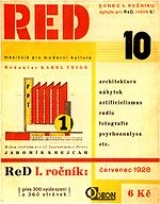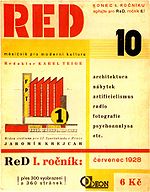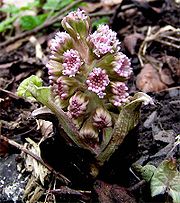
Devetsil
Encyclopedia

Czech people
Czechs, or Czech people are a western Slavic people of Central Europe, living predominantly in the Czech Republic. Small populations of Czechs also live in Slovakia, Austria, the United States, the United Kingdom, Chile, Argentina, Canada, Germany, Russia and other countries...
avant-garde
Avant-garde
Avant-garde means "advance guard" or "vanguard". The adjective form is used in English to refer to people or works that are experimental or innovative, particularly with respect to art, culture, and politics....
artists, founded in 1920 in Prague
Prague
Prague is the capital and largest city of the Czech Republic. Situated in the north-west of the country on the Vltava river, the city is home to about 1.3 million people, while its metropolitan area is estimated to have a population of over 2.3 million...
. From 1923 on there was also an active group in Brno
Brno
Brno by population and area is the second largest city in the Czech Republic, the largest Moravian city, and the historical capital city of the Margraviate of Moravia. Brno is the administrative centre of the South Moravian Region where it forms a separate district Brno-City District...
. The movement discontinued its activities in 1930 (1927 in Brno).
Founded as U. S. Devětsil (Umělecký Svaz Devětsil - Devětsil Artistic Federation), its name was changed several times. From 1925, it was called the Svaz moderní kultury Devětsil (the Devětsil Union of Modern Culture).
The artistic output of its members was varied, but typically focused on magic realism
Magic realism
Magic realism or magical realism is an aesthetic style or genre of fiction in which magical elements blend with the real world. The story explains these magical elements as real occurrences, presented in a straightforward manner that places the "real" and the "fantastic" in the same stream of...
, proletkult
Proletkult
Proletkult was movement which arose in the Russian revolution and was active from 1917 to 1925 which aspired to provide the foundations for what was intended to be a truly proletarian art devoid of bourgeois influence.The name is a portmanteau of "proletarskaya kultura" , which are better-known as...
, and, beginning in 1923, Poetism, an artistic program formulated by Vítězslav Nezval
Vítezslav Nezval
Vítězslav Nezval was one of the most prolific avant-garde Czech writers in the first half of the twentieth century and a co-founder of the Surrealist movement in Czechoslovakia....
and Karel Teige
Karel Teige
Karel Teige was the major figure of the Czech avant-garde movement Devětsil in the 1920s, a graphic artist, photographer, and typographer...
.
The group was very active in organizing the Czech art scene of the period. Members published several art magazines - ReD (Revue Devětsilu), Disk and Pásmo, as well as occasional anthologies (most importantly Devětsil and Život) and organized several exhibitions.
For the most part, Devětsil artists produced poetry and illustration, but they also made contributions to many other art forms, including sculpture, film and even calligraphy
Calligraphy
Calligraphy is a type of visual art. It is often called the art of fancy lettering . A contemporary definition of calligraphic practice is "the art of giving form to signs in an expressive, harmonious and skillful manner"...
.
For about two years Devětsil functioned without any particular theoretical grounding, but as the members changed and those that remained developed and modified their style, it was decided, particularly by Karel Teige, that they begin formulating theories behind their activity. Most of these theories were to be spread through manifestos published by the group. Like any good theorist, Teige was always ready to change his ideas and sometimes moved from one aesthetic to an opposite one. The group formulated a movement that they called Poetism. The long echoed cry, “make it new,” was vital to the Poetists way of thinking. The Devětsil members were surrounded by the new in science, architecture and industry. Even their country was new. In order for art to survive, or at least in order to be worthwhile, it had to constantly be ahead of other changes in life. The Poetists advocated the law of antagonism. This law explains historical progress as reliant on discontinuity. New types and styles of art are continuously necessary for development and vital to these changes are conditions of contradiction. The first manifesto of Devětsil urged new artists to look deeper into ordinary objects for poetic quality. Skyscrapers, airplanes, mimes, and poster lettering were the new arts. Inspired by the Berlin Dadaists, Seifert claimed “art is dead.” Following him, Teige remarked, “the most beautiful paintings in existence today are the ones which were not painted by anyone.”
Between 1923 and 1925, the picture poem was a popular form among the Devětsil artists. Typography and optical poetry was the new lexical standard. Teige explained this transformation of language into visual art as relating to the rise of photography, film and new developments in book printing. For several members of Devětsil, the picture poem replaced painting and eventually both pictures and poems made their way from the page to film. Teige and Seifert began writing film scripts and using the dissolve technique as a way of poetically morphing objects into other objects.
Significant Members

- Karel TeigeKarel TeigeKarel Teige was the major figure of the Czech avant-garde movement Devětsil in the 1920s, a graphic artist, photographer, and typographer...
- Jaroslav SeifertJaroslav SeifertJaroslav Seifert was a Nobel Prize winning Czech writer, poet and journalist.Born in Žižkov, a suburb of Prague in what was then part of Austria-Hungary, his first collection of poems was published in 1921...
- Vladislav VančuraVladislav VancuraVladislav Vančura was one of the most important Bohemian writers of the 20th century...
- Adolf Hoffmeister
Most influential members:
- Karel TeigeKarel TeigeKarel Teige was the major figure of the Czech avant-garde movement Devětsil in the 1920s, a graphic artist, photographer, and typographer...
- Vítězslav NezvalVítezslav NezvalVítězslav Nezval was one of the most prolific avant-garde Czech writers in the first half of the twentieth century and a co-founder of the Surrealist movement in Czechoslovakia....
- Jaroslav SeifertJaroslav SeifertJaroslav Seifert was a Nobel Prize winning Czech writer, poet and journalist.Born in Žižkov, a suburb of Prague in what was then part of Austria-Hungary, his first collection of poems was published in 1921...
Poets:
- Konstantin BieblKonstantin BieblKonstantin Biebl was a Czech poet.-Biography:Konstantin Biebl was born in Slavětín near Louny, Bohemia, then Austria-Hungary. His father was a dentist in Louny, apt to write poetry and paint. He committed suicide in 1916 when he served as a surgeon in Galicia.. Arnošt Ráž, a brother of...
- František HalasFrantišek HalasFrantišek Halas was one of the most significant Czech lyric poets of the 20th century, an essayist, and a translator.- Life :...
- Jindřich Hořejší
- Jiří WolkerJirí WolkerJiří Wolker was a Czech poet, journalist and playwright. He was one of the founding members of CPC - Communist Party of Czechoslovakia in 1921.- Life :...
Architects:
- Jaroslav Fragner
- Jan Gillar
- Josef Havlíček
- Karel Honzík
- Josef ChocholJosef ChocholJosef Chochol was a Czech architect.-Education:Chocol studied architecture at the polytechnic in Prague , then at the academy in Vienna, under guidance of Otto Wagner .-Career:...
- Jaromír KrejcarJaromír KrejcarJaromír Krejcar was a Czech functionalistic architect, student of Jan Kotěra and member of Devětsil.He collaborated with Czech structural engineer, Dr...
- Evžen Linhart
- Pavel Smetana
Actors:
- Jiří VoskovecJirí VoskovecJiří Voskovec was a Czech-American actor, playwright, dramatist, director, translator, and poet...
- Jan WerichJan WerichJan Werich was a Czech actor, playwright and writer.-Life:Between 1916 to 1924 he attended "reálné gymnasium" in Křemencová Street in Prague...
Musicians:
- Jaroslav JežekJaroslav JežekJaroslav Ježek was a Czech composer, pianist and conductor, author of jazz, classical, incidental and film music.- Life :...
Directors:
- Jiří Frejka
- Emil František BurianEmil František BurianEmil František Burian was a Czech poet, journalist, singer, actor, musician, composer, dramatic adviser, playwright and director. He was also active in Communist Party of Czechoslovakia politics.- Life :...
- Jindřich Honzl
Writers:
- Karel Konrád
- Vladislav VančuraVladislav VancuraVladislav Vančura was one of the most important Bohemian writers of the 20th century...
- Julius FučíkJulius Fucíkthumb|Julius FucikJulius Fučík was a Czechoslovak journalist, an active member of Communist Party of Czechoslovakia , and part of the forefront of the anti-Nazi resistance. He was imprisoned, tortured, and executed by the Nazis.- Early life :Julius Fučík was born into a working-class family in...
Painters:
- Adolf Hoffmeister
- Otakar Mrkvička
- František Muzika
- Jindřich ŠtyrskýJindrich ŠtyrskýJindřich Štyrský was a Czech Surrealist painter, poet, editor, photographer, and graphic artist....
- ToyenToyenMarie Čermínová , known as Toyen, was a Czech painter, draftsperson and illustrator and a member of the surrealist movement.-Biography:...
Photographer:
- Jaroslav RösslerJaroslav RösslerJaroslav Rössler was a pioneer of Czech avant-garde photography and a member of the association of Czech avant-garde artists Devětsil .- Biography :...
Teoretics:
- Jiří Frejka
- Bedřich Václavek
External links
- Poetism in Book Design from Czech Book Covers of the 1920s and 1930s in the Cooper-Hewitt national Design Museum Library (2004) Steven H. VanDyk

